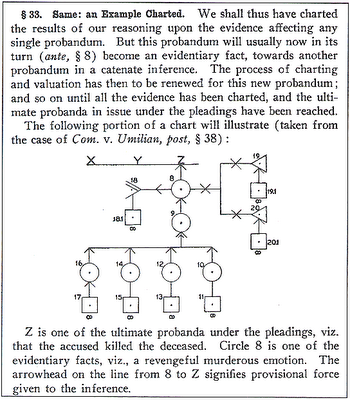 "My computer screen is festooned with little cartoons that do various things when selected by a click of the mouse. For the life of me I can't remember what the tiny binoculars, eyedropper, and silver platter are supposed to do. A picture is worth a thousand words, but that is not always such a good thing. At some point between gazing and thinking, images must give way to ideas." Steven Pinker, Chapter 4 ("The Mind's Eye"), How the Mind Works p. 298 (1997).
"My computer screen is festooned with little cartoons that do various things when selected by a click of the mouse. For the life of me I can't remember what the tiny binoculars, eyedropper, and silver platter are supposed to do. A picture is worth a thousand words, but that is not always such a good thing. At some point between gazing and thinking, images must give way to ideas." Steven Pinker, Chapter 4 ("The Mind's Eye"), How the Mind Works p. 298 (1997).This thought has many implications for visualizing evidence. One implication is the following:
The mental labor required by a method of picturing evidence and inference ordinarily should not outweigh the cognitive benefits of using such that method.Compare the following lead balloon produced by the ordinarily-superlative John Henry Wigmore:
 Even though Wigmore's method of picturing inference was far from user-friendly, it is good that Wigmore created his leaden method of charting evidence and inference. For example, his effort helped to get some legal professionals to start thinking about inference networks and it eventually helped to get probabilists to think more carefully about cascaded probabilistic inference and about the peculiar and interesting properties of complex evidential inference.
Even though Wigmore's method of picturing inference was far from user-friendly, it is good that Wigmore created his leaden method of charting evidence and inference. For example, his effort helped to get some legal professionals to start thinking about inference networks and it eventually helped to get probabilists to think more carefully about cascaded probabilistic inference and about the peculiar and interesting properties of complex evidential inference.

No comments:
Post a Comment